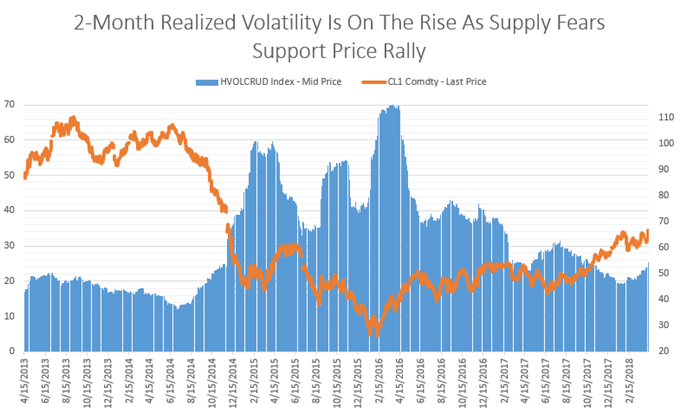Fundamental FX Factors To Watch Focus:
- Geopolitical risk is the key factor adding volatility through supply shock fears
- The Fed's March Minutes shows that inflation is becoming an upside risk, yikes
- Caution remains the order of that day, not panic as EM risks escalate
Tensions in the Middle East has become a buzz phrase that has the market’s attention once again. On the one hand, concerns about an escalating ‘trade war’ have died down after Chinese President Xi Jinping gave the Keynote Address at the Boao Forum for Asia.
Unfortunately, a parting of geopolitical storm clouds that is supporting the US Dollar and risk assets and seeing havens like Gold sell-off is often the wrong kind of calm in markets. In other words, the short-term lack of bad is not an absolute good.
At the same time, the flattening US Yield Curve where the yields between the US Treasury 2-year and the 10-year yield is back in the limelight suggesting the Federal Reserve may be further along in their rate hiking cycle than markets are anticipating.
Access our best Trading Guides here (they're free)
Trade War Fears Give Way to War War Likely Leading to Commodity Supply Shocks
The ‘trade war’ fear was often seen as a move likely to be given a chapter in US President Trumps presumed post-Oval Office book, The Art of the Deal, Executive Branch Edition. On the one hand, without retaliation, “winning” a trade war can lead to reducing the deficit and boosting short-run growth. However, a fine line has to be walked as retaliation via tariffs often leads to a worsening deficit, inflation pressures and deteriorating economic performance.
Either way, the markets appeared to have a short sigh of relief when China President Xi Jinping offered a conciliatory tone at his Keynote Address at the Boao Forum for Asia earlier this week. Jinping offered to open sectors in the Chinese economy and to lower import tariffs in varying industries. Trump praised the speech and markets celebrated with the all-too-common equities rally.
However, on Wednesday, a threat from Trump for Russia to ‘Get Ready’ as missiles will likely be heading to Syria brought initial concerns that were stoked further when reports were verified that Saudi Arabia intercepted advanced missiles from Yemen. The missiles were aimed at the capital of Saudi, Riyadh and key infrastructures that transfer extracted oil. Naturally, the fear is that the advanced state of Yemeni missiles could pose a major threat to supplies of crude oil that are already backward dated in the futures market, more on that later.
Another key factor that has brought concerns of a disruption in commodity supply that could lead to higher prices and inflation is recently announced sanctions. This week, Aluminum has reached the highest levels since 2012 amid sanction against the owner of Aluminum mega-producer, Rusal from Russia caused large buyers of the metals to seek another provider, which is not likely to be a fruitful search. Currently, the seven-day, 16% rally is the biggest rally recorded since Bloomberg began records in 1987.
Flattening Yield Curve Shows the Melt-Up May Continue, But Fed Action Is Advanced
FOMC minutes on Wednesday showed that inflation is coming, and it is now, for the first time since the Fed gave forward guidance to stabilize the economy after the great recession an upside risk. Upside risk is finance speak for being concerned about possible upside shocks.
While inflation has killed many economic growth cycles in the history of markets, inflation has been oddly dormant and it’s lack of whereabouts have caused central bankers to plug the financial system with trillions of dollars in orders to get inflation back on the scene. Well, according to the latest minutes from the March Federal Reserve meeting, inflation may jump and jump fast, which may very well mean that the economic cycle is advanced and the Fed may need to hike fast in order to prevent inflation from running away.
Chart: US 2/10 Yield Curve (Blue) Inversion Often Precedes Recessions (Orange)

Data source: Bloomberg
Other key takeaways from the March FOMC Minutes were that in addition to more tightening seen as warranted, growth is seen being boosted significantly by upcoming Fiscal policy while confidence is growing that inflation will return to 2%.
From the Fed’s point of view, the key risk becomes whether or not the 10-year yield can begin to match the Fed’s expected terminal rate, currently near 3.37%. If the 10-year UST yield fails to surpass 3%, currently the high has been 2.95%, the Fed may need to begin lowering their terminal rate, which could wreak havoc on the US Dollar by taking away tightening that is already pricedinto the USD.
Jeremy Grantham, one of the founders of the fund management group GMO sounded the warning that the combination of high profits and low inflation have been a perfect environment for unusually high valuations. High valuation leads to aggressive M&A and stock returns. However, Grantham argues that rising inflation will soon translate into higher nominal and real interest rates that will soon cause wage pressures to cut into profits and drop the ‘free-ride’ that markets have enjoyed thanks to accommodative Fed policy and unusually low inflation. For what it’s worth, his advice was to look to emerging markets where growth still has the potential to out-perform.
A New Kind of Volatility Is Perking Up in the Commodity Space

Data source: Bloomberg
Oil volatility is at the highest level in two-months with volatility favoring upside gains due to fears of supply shocks.
As you can see above, most volatility (blue area) has been associated with price declines as the 2-month realized volatility exploded to 80 when price hit the likely nadir of the decade in early 2016. However, 60-day realized volatility recently touched a 2-month high as bullish price pressures due to likely falling supply could support the bull-trend further.
Chart: Oil Supply Shock Fears Are Getting Price In To The Market

Data source: Bloomberg
One of my favorite ways to visualize demand vs. supply pressure is futures market spreads. The fears of a shortage of supply is seen most clearly in the spreads of futures contracts between the December 2019 futures contract and the December 2020 futures contract for Brent Crude Oil.
A rising blue line shows the benefit of buying and carrying the commodity is increasingly exceeding the cost of buying carrying the commodity despite storage costs, insurance, and the like. When the blue line is rising, inflation often is as well and sellers may want to think twice.
New to FX trading? No worries, we created this guide just for you.
---Written by Tyler Yell, CMT
Tyler Yell is a Chartered Market Technician. Tyler provides Technical analysis that is powered by fundamental factors on key markets as well as t1rading educational resources. Read more of Tyler’s Technical reports via his bio page.
Communicate with Tyler and have your shout below by posting in the comments area. Feel free to include your market views as well.
Discuss this market with Tyler in the live webinar, FX Closing Bell, Weekdays Monday-Thursday at 3 pm ET.
Talk markets on twitter @ForexYell
Join Tyler’s distribution list.






